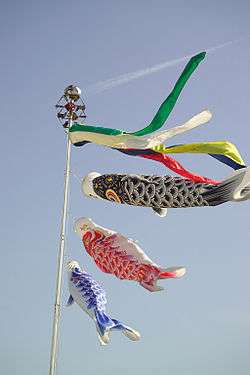Children's Day (Japan)
| Children's Day | |
|---|---|
 | |
| Observed by | Japan |
| Type | National |
| Significance | Celebrates children's personalities and their happiness |
| Date | May 5 |
| Related to | Golden Week (Japan), Tango no Sekku, Duanwu Festival, Dano Festival, Tết Đoan Ngọ |
Children's Day (こどもの日 Kodomo no Hi) is a Japanese national holiday which takes place annually on May 5 and is the final celebration in Golden Week. It is a day set aside to respect children's personalities and to celebrate their happiness. It was designated a national holiday by the Japanese government in 1948. It has been a day of celebration in Japan since ancient times.
History
The day was originally called Tango no sekku (端午の節句) – one of the five annual ceremonies held at the imperial court – and was celebrated on the fifth day of the fifth moon in the Chinese calendar. After Japan switched to the Gregorian calendar, the date was moved to May 5.[2] It was originally exclusively male celebrating boys and recognizing fathers, but has since been changed to include both male and female children, as well as recognizing mothers along with fathers and family qualities of unity.
Until 1948, Children's Day was known as Boys' Day (also known as Feast of Banners) while Girls' Day (Hinamatsuri) was celebrated on March 3. At that time, the government decreed this day to be a national holiday to celebrate the happiness of all children and to express gratitude toward mothers. It was renamed Kodomo no Hi.[3]
Celebration
On this day, families raise the carp-shaped koinobori flags (carp because of the Chinese legend that a carp that swims upstream becomes a dragon and flies to Heaven,[4] and the way the flags blow in the wind looks like they are swimming), with one carp for the father, one for the mother, and one carp for each child (traditionally each son). Families may also display a samurai doll usually riding on a large carp (often representing the Japanese folk heroes Kintarō or Momotarō), and/or the traditional Japanese military helmet, kabuto, due to their tradition as symbols of strength and vitality.[3]
Mochi rice cakes wrapped in kashiwa (oak) leaves – kashiwa-mochi (mochi filled with red bean jam) and chimaki (a kind of "sweet rice paste", wrapped in an iris or bamboo leaf) – are traditionally served on this day.[3][5]
See also
References
- ↑ Perkins, Dorothy (1991). Encyclopedia of Japan: Japanese History and Culture, from Abacus to Zori. Facts on File. p. 46. ISBN 9780816019342. Retrieved May 3, 2018.
- ↑ Nussbaum, Louis Frédéric and Käthe Roth. (2005). Japan Encyclopedia. Cambridge: Harvard University Press. ISBN 978-0-674-01753-5; OCLC 48943301, p. 948
- 1 2 3 Kigawa, Michiyo. "Kodomo no hi: Children's Day Celebration". About Japan: A Teacher's Resource. Japan Society. Retrieved May 3, 2018.
- ↑ "端午の節句と5月人形" [Tango no sekku and May dolls] (in Japanese). Japanese Doll Association. Retrieved May 7, 2014.
- ↑ Louie, Elaine (May 1, 1991). "For Children's Day, Sweets, Of Course". The New York Times. Retrieved May 3, 2018.
External links
| Wikisource has the text of the 1911 Encyclopædia Britannica article Banners, Feast of. |
| Wikisource has the text of the 1911 Encyclopædia Britannica article Banners, Feast of. |